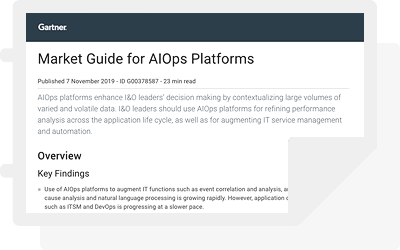Gartner recently released their Market Guide for AIOps Platforms, which discusses what the AIOps software marketplace looks like and how Gartner believes Infrastructure and Operations (I&O) leaders should begin implementing their AIOps deployments over the next five years.
Why it’s important
AIOps stands for Artificial Intelligence for IT Operations. AIOps refers to multi-layered technology platforms that automate and enhance IT operations by using analytics and machine learning to analyze big data collected from various IT operations tools and devices. AIOps platforms help IT Ops departments automatically spot, react to, and report on IT Ops issues in real time. Check out our primer on what AIOps is for more information on the AIOps platform, what’s driving it, and the big advantages for AIOps implementation.
Gartner estimates that only 5% of all large enterprises are currently combining big data and machine learning (the heart of an AIOps platform) to support and partially replace monitoring, service desk, and automation processes and tasks. However, Gartner expects that number to jump to 40% of all large enterprises by 2022. If this prediction comes true, AIOps will create a massive shift in IT Operations methodology and spending, and it benefits everyone to understand what vendors, products, and services make up the AIOps marketplace.
What makes for an AIOps product?
When looking for products in the AIOps marketplace, it helps to remember that AIOps is a multi-layered platform consisting of the elements shown in figure 1.

Figure 1: The technology layers that make up an AIOps platform
Remember: the goal of an AIOps implementation is to gather and consolidate operational information into a big data platform, and then use analytics and machine learning to identify, react to, and report on IT issues in real time. In their Market Guide for AIOps Platforms, Gartner classifies AIOPS products supporting that goal into eleven different categories, including:
- Historic data management – A big data management solution for storing and accessing historical data from the many different data sources that feed an AIOps environment.
- Streaming data management – Software that allows for real-time capture (as opposed to historical capture) and presentation of the data sources feeding the environment.
- Log data ingestion – Software that captures alphanumeric text strings from applications and hardware devices, and prepares that data for analysis, access, and indexing for storage.
- Wire data ingestion – Software that captures packet data from network taps for analysis, access, and indexing for storage.
- Metric data ingestion – Software for the capture, analysis, and access to time series and general mathematical operations performed on I&O data.
- Document text ingestion – Software for the capture, parsing, and syntactical and semantic indexing of human readable documents, including natural language processing (NLP).
- Automated pattern discovery and prediction – Software that uses historical and streaming data to detect patterns describing correlations that can be inferred from the captured datasets. Discovered patterns are predictive, foretelling future events with different degrees of probability.
- Anomaly detection – Software that uses discovered patterns to determine baseline system behavior and detect departures from that normal behavior.
- Root cause determination – Software that cuts through the pattern discovery and prediction components of an AIOps platform and finds the most genuine cause and effect relationships that may need attention.
- On-premises delivery – The ability to deliver any of the other AIOps software elements as an internal on-premises solution.
- Software as a service – The ability to deliver AIOPs software elements as a cloud offering.
Each of these categories fits into and supports one or more of the AIOps technology listed in figure 1. There are several different vendors who provide AIOps enabling software, including BMC, IBM, SAP, Splunk, and others. Like most software categories, not every vendor provides products in each category and it’s best to look at the vendor’s full range of AIOps offerings and consider future needs as you start deploying your own AIOps platform. A good starter list of AIOps vendors and the AIOps software categories they provide is included in Gartner’s Market Guide for AIOps Platforms.
Gartner’s recommendations for getting started
In addition to describing the AIOps categories and providing a starter list of vendor who provide products in each category, Gartner also offers the following recommendations for getting started with AIOps (note: I’m paraphrasing their recommendations. See the Market Guide for their full recommendations).
- Start small and use an incremental approach to AIOps that initially focuses on historical data. Incrementally deploy AIOps functionality, starting with analyzing and accessing historical data and then add stream data access and analysis later. Master the big data aspects of AIOps before moving on to its other capabilities. Look for tools and services that allow you to ingest, store, and access data independently of the other AIOps components.
- Select AIOps platforms capable of supporting a broad range of historical and streaming data types. Your AIOps platform should ingest, provide access to, and analyze a broad range of historical and streaming data types, including logs, wire data, metrics, and text capture. A wide variety of data types will allow for a much broader analysis of trends and issues within your IT Ops environment.
- Choose tools that allow you to incrementally deploy the four phases of IT Operations-oriented analytics and machine learning. As I discussed in an earlier post about the new AIOps skills that IT Ops personnel must master, IT Ops will need a deep understanding of how their AIOps environments are producing the outcomes they are recommending or automatically implementing. Advancing that idea, Gartner also recommends incrementally deploying these four phases of IT Operations-oriented machine learning.
- Visualization and statistical analysis
- Automated pattern discovery
- Pattern-based predication
- Root cause analysis
Per Gartner, deploying AIOps in an IT Operations environment is difficult and must be approached gradually. Organizations should resist the temptation to try implementing all AIOps functionality at once. Rather, they should first concentrate on visualization and statistical analysis. After becoming adept at visualization and statistical analysis, you can move on to the other three phases in sequence. Similar to the old saw about how you eat an elephant (one bite at a time), you should build your AIOps solutions and environment one bite at a time to ensure long-term success. Be sure to look for tools that can modularly deploy solutions in all machine learning phases, so you can build up your solutions and obtain additional value as you learn.
Doing your homework now
AIOps is a rising and important platform in the IT Operations world. It’s important to get familiar with the concepts, software, and vendors who will control this marketplace, because if you’re in a medium to large IT organization, chances are good you’ll be looking at AIOps deployment within the next five years.







